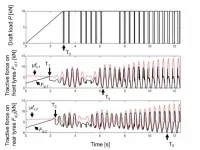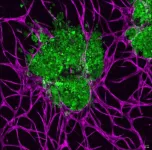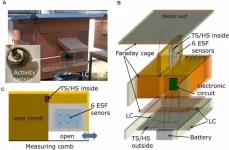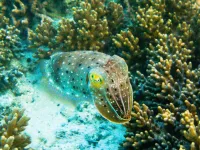Staying down on the farm
Researchers at Tokyo University of Agriculture and Technology (TUAT) use nonlinear dynamics to understand the origin of potentially dangerous self-excited oscillations during tractor operation, which may increase safety in industrial situations
2021-05-04
(Press-News.org) Tokyo, Japan - Researchers at Tokyo University of Agriculture and Technology (TUAT) modeled the dynamic instability--the so-called "power hop"--that can cause uncontrollable bouncing and damage tractors when they plow dry ground. The team found that self-excited oscillations can arise when the tractor pushes against the ground.
Plowing a field on a tractor may seem like a serene occupation, but sudden vibrations can grow unexpectedly and threaten to topple you under certain conditions. The problem is that in nonlinear systems with coupled components, as with a mechanical tractor, small shakes can grow exponentially until they become large oscillations. For tractors, this is called a "power hop." To better understand this potentially hazardous situation, researchers at TUAT simulated equations corresponding to the vertical, longitudinal, and pitching motion of the tractor.
"Our model reflects dynamics such as bouncing, stick-slip friction, and free-play, which were missing from some previous attempts to model this complex system," first author Masahisa Watanabe says. The equations were simulated using the fourth-order Runge-Kutta method on a millisecond scale.
In the numerical simulation using the developed model, power hop occurrence mechanism was described in the following figure.
In the simulation, draft load draft load P was increased from 0 to 10 kN. As the draft load increased, the tractive force on the front and rear tires also increased. At the point T1, the front tractive forces reached the limitation of the static friction μfv,1 and there was stick-slip oscillation. This oscillation leads to variation of the vertical loads and tractive forces. This variation in the vertical load acting on the rear tires caused the stick slip dynamics of the rear tires at the point T2. When the oscillation became severe, the tractive forces reduced and there was free play at the point T3. Vertical loads acting on the front and rear tires became zero and the front and rear tyres lost contact with the ground at points T4 and T5 respectively.
This approach allowed the researchers to construct bifurcation diagrams showing regions of stability and when power hop dynamics began. The model showed that power hop can occur based on the drawbar pull, soil, and tire conditions.
The highest risk of power hop involved situations with high-draft loads on dry soil. That is, a dangerous feedback loop started during bouncing, leading to complete loss of traction with the ground. The model was even able to explain why this instability is much more likely to occur in four-wheel drive tractors. "The results we obtained agree with conventional wisdom from farmers about power hops, as well as with previous experiments," senior author Kenshi Sakai says. Nonlinear coupling between moving parts can happen in many industrial settings, and understanding how to avoid chaotic dynamics or uncontrolled vibrations can lead to safer factories and farms.
INFORMATION:
The work is published in Biosystems Engineering as "Novel power hop model of an agricultural tractor coupling bouncing, stick-slip, and free-play dynamics" (DOI: doi.org/10.1016/j.biosystemseng.2021.01.007).
About Tokyo University of Agriculture and Technology (TUAT)
TUAT is a distinguished university in Japan dedicated to science and technology. TUAT focuses on agriculture and engineering that form the foundation of industry, and promotes education and research fields that incorporate them. Boasting a history of over 140 years since our founding in 1874, TUAT continues to boldly take on new challenges and steadily promote fields. With high ethics, TUAT fulfills social responsibility in the capacity of transmitting science and technology information towards the construction of a sustainable society where both human beings and nature can thrive in a symbiotic relationship. For more information, please visit http://www.tuat.ac.jp/en/.
Original publication:
Masahisa Watanabe, Kenshi Sakai.
Novel power hop model for an agricultural tractor with coupling bouncing, stick-slip, and free-play dynamics,
Biosystems Engineering, Volume 204, 2021, Pages 156-169,
https://doi.org/10.1016/j.biosystemseng.2021.01.007.
Contact:
Kenshi Sakai, Ph. D
Professor
Department of Environment Conservation, Graduate School of Agriculture, Tokyo University of Agriculture and Technology, Japan
e-mail: ken@cc.tuat.ac.jp
[Attachments] See images for this press release:

ELSE PRESS RELEASES FROM THIS DATE:
2021-05-04
A synthetic approach that improves absorber layers in perovskite solar cells could help them achieve their full potential and draw closer to the performance of leading gallium arsenide devices.
Solar cells that rely on perovskite thin films to capture sunlight are the fastest growing photovoltaic technology. Cheaper and easier to manufacture and incorporate into devices than conventional semiconductors, lead halide perovskites also effectively absorb visible light and display long charge carrier diffusion lengths -- an indicator of their ability to maintain light-induced electrons and holes separation and facilitate charge transport.
Performance ...
2021-05-04
A new Boston University School of Public Health (BUSPH) study has identified for the first time how the aryl hydrocarbon receptor (AhR), an environmental chemical receptor, drives immunosuppression in oral squamous cell carcinoma (OSCC)--and that its removal from malignant cells can result in tumor rejection.
Published in the journal Proceedings of the National Academy of Sciences, the study findings provide new insight into the biology of cancer immunosuppression, and identify a new target for cancer immunotherapy treatment.
Immune checkpoint inhibitors (immunotherapy drugs) are some of the most important treatments that have emerged for treating many cancers, including OSCC. Targeting immune checkpoint molecules such as PD-1, ...
2021-05-04
Measures to contain the Corona pandemic are the subject of politically charged debate and tend to polarize segments of the population. Those who support the measures motivate their acquaintances to follow the rules, while those who oppose them call for resistance in social media. But how exactly do politicization and social mobilization affect the incidence of infection? Researchers at the Max Planck Institute for Human Development have examined this question using the USA as an example. Their findings were published in Applied Network Science.
Limit crowds, keep a safe distance, and wear masks. Such non-pharmaceutical ...
2021-05-04
Cancerous tumors thrive on blood, extending their roots deep into the fabric of the tissue of their host. They alter the genetics of surrounding cells and evolve to avoid the protective attacks of immune cells. Now, Penn State researchers have developed a way to study the relationship between solid, difficult-to-treat tumors and the microenvironment they create to support their growth.
The method has the potential to act as a testbed for drugs and other anticancer treatments, according to Ibrahim T. Ozbolat, associate professor of engineering science and mechanics and biomedical engineering, who led the research. The details of the approach were published in Advanced Biology.
Using ...
2021-05-04
Despite human inventiveness and ingenuity, we still lag far behind the elegant and efficient solutions forged by nature over millions of years of evolution.
This also applies for buildings, where animals and plants, have developed extremely effective digging methods, for example, that are far more energy-efficient than modern tunnelling machines, and even self-repairing foundations that are unusually resistant to erosion and earthquakes (yep, we're talking about roots here).
Researchers from all over the world are therefore seeking inspiration in nature to develop the buildings of the future, and researchers from Aarhus University ...
2021-05-04
Honeybees have a complex communication system. Between buzzes and body movements, they can direct hive mates to food sources, signal danger, and prepare for swarming - all indicators of colony health. And now, researchers are listening in.
Scientists based in Germany - with collaborators in China and Norway - have developed a way to monitor the electrostatic signals that bees give off. Basically, their wax-covered bodies charge up with electrostatic energy due to friction when flying, similar to how rubbing your hair can make it stand on end. That energy then gets emitted during communications.
"We were thrilled by the ...
2021-05-04
The majority of top-rated fertility apps collect and even share intimate data without the users' knowledge or permission, a collaborative study by Newcastle University and Umea University has found.
Researchers are now calling for a tightening of the categorisation of these apps by platforms to protect women from intimate and deeply personal information being exploited and sold.
For hundreds of millions of women fertility tracking applications offer an affordable solution when trying to conceive or manage their pregnancy. But as this technology grows in popularity, experts have revealed that most of the top-rated fertility apps collect and share sensitive ...
2021-05-04
T-cell acute lymphoblastic leukemia (T-ALL) is a very aggressive type of blood cancer. It is relatively rare but still draws a lot of attention as it mostly develops in children under the age of 20. The standard treatment for T-ALL involves heavy chemotherapy procedures, which result in favorable outcomes with an overall survival of 75% after 5 years.
However, some patients do not respond to this treatment, or they only respond for a short period, after which the disease grows back. These patients therefore need alternative therapies.
Researchers from the Faculty of Health and Medical Sciences, University of Copenhagen, have now identified a combination treatment, which could potentially benefit patients ...
2021-05-04
University of Bristol research into octopus vision has led to a quick and easy test that helps optometrists identify people who are at greater risk of macular degeneration, the leading cause of incurable sight loss.
The basis for this breakthrough was published in the latest issue of the Journal of Experimental Biology and describes new technology developed by lead researcher, Professor Shelby Temple, to measure how well octopus- which are colour-blind - could detect polarized light, an aspect of light that humans can't readily see. Using this novel technology, the research team showed that octopus have the most sensitive polarization vision system of any animal tested to date. Subsequent research ...
2021-05-04
When COVID-19 patients began filling up ICUs throughout the country in 2020, health care providers faced difficult decisions. Health care workers had to decide which patients were most likely to recover with care and which were not so resources could be prioritized.
But a new paper from the University of Georgia suggests that unconscious biases in the health care system may have influenced how individuals with intellectual disabilities were categorized in emergency triage protocols.
The state-level protocols, while crucial for prioritizing care during disasters, frequently ...
LAST 30 PRESS RELEASES:
[Press-News.org] Staying down on the farm
Researchers at Tokyo University of Agriculture and Technology (TUAT) use nonlinear dynamics to understand the origin of potentially dangerous self-excited oscillations during tractor operation, which may increase safety in industrial situations



